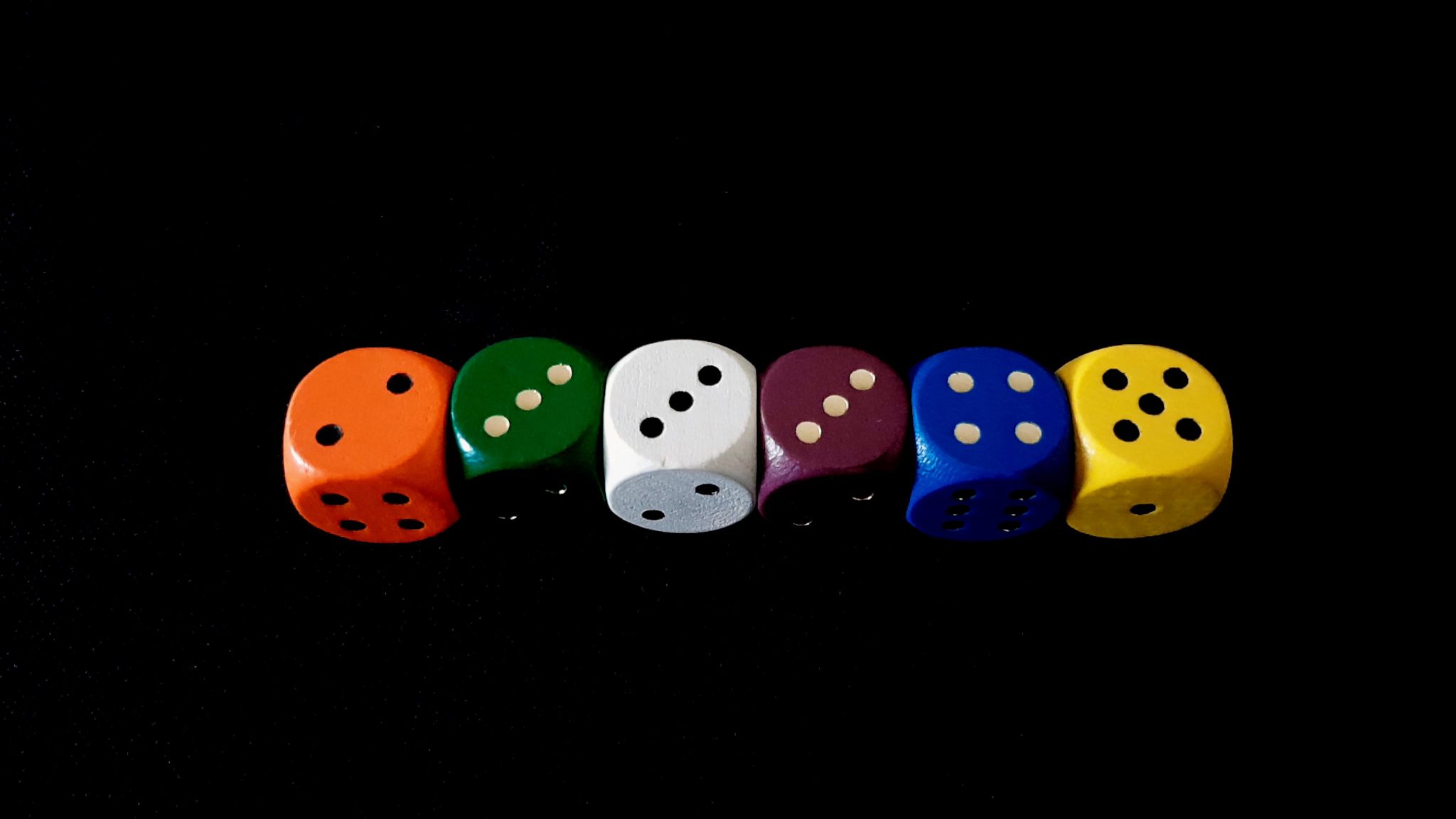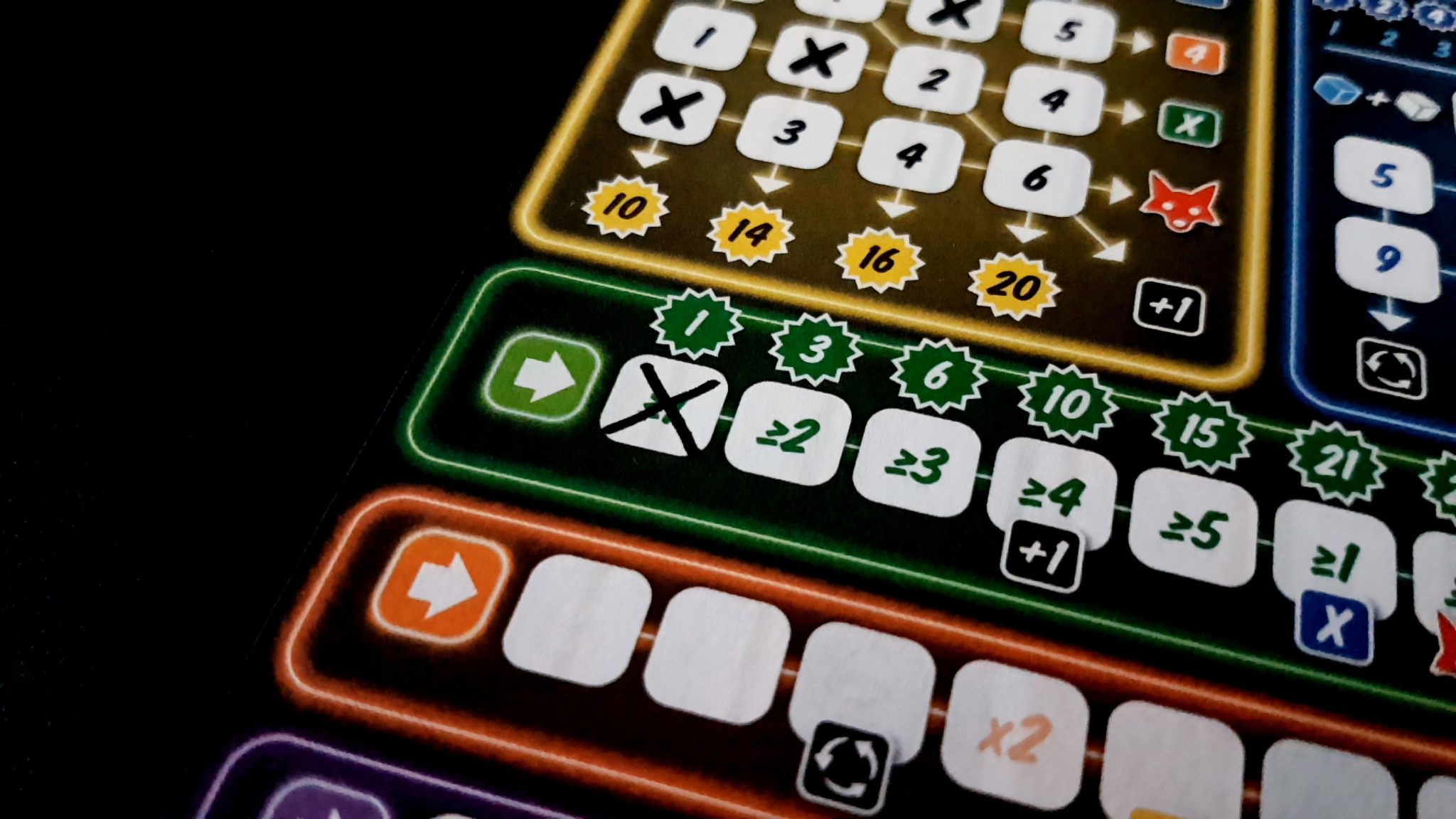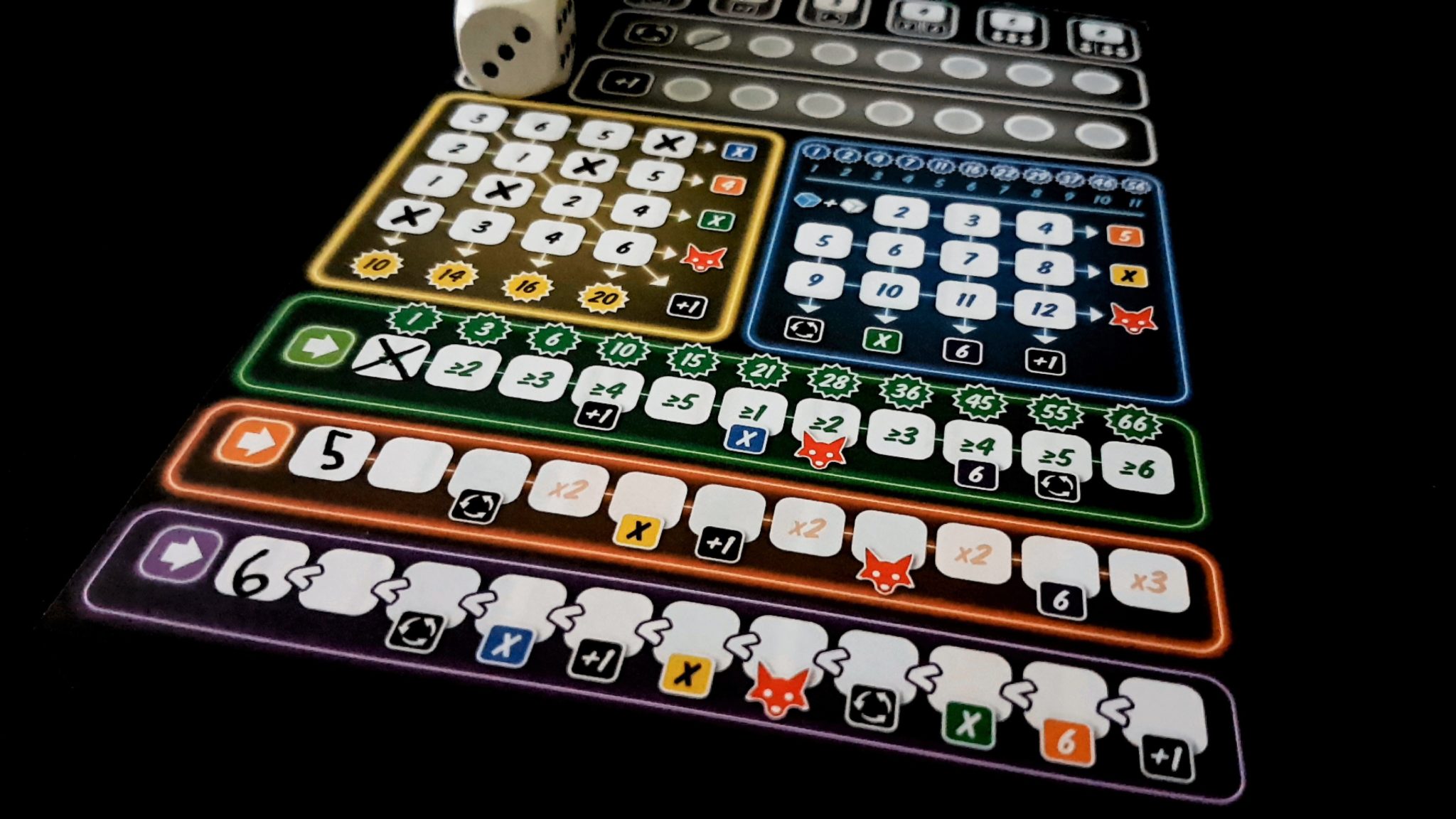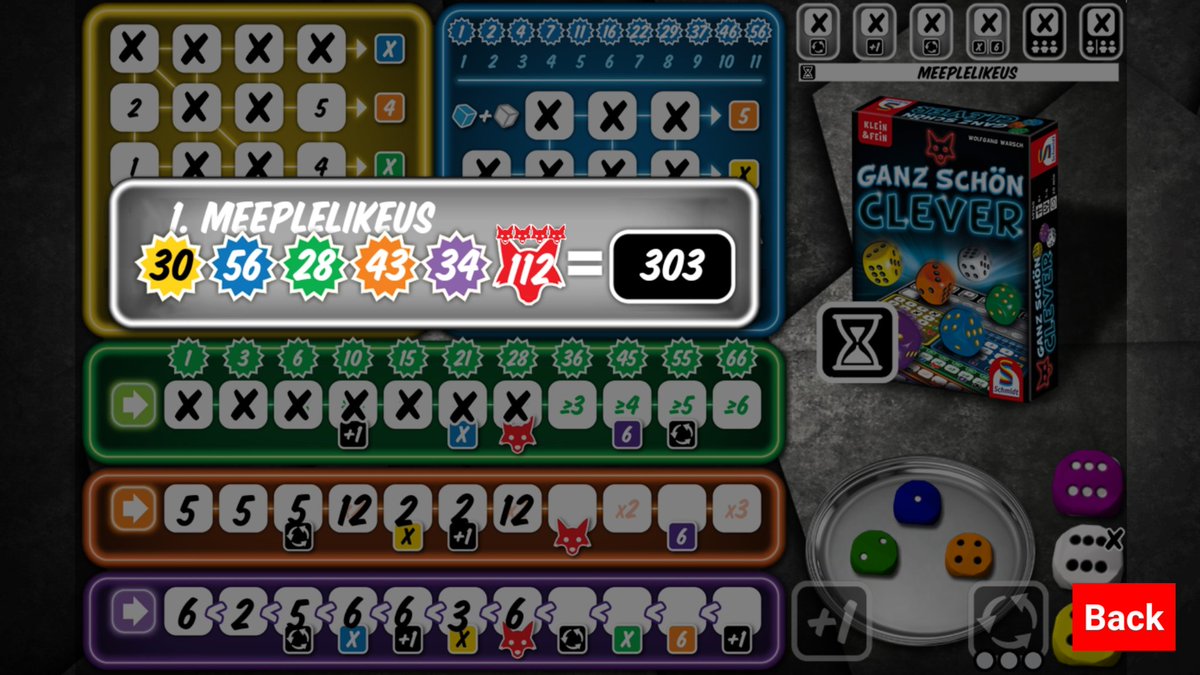| Game Details | |
|---|---|
| Name | That's Pretty Clever! (2018) |
| Accessibility Report | Meeple Like Us |
| Complexity | Medium Light [1.87] |
| BGG Rank | 178 [7.57] |
| Player Count | 1-4 |
| Designer(s) | Wolfgang Warsch |
| Buy it! | Amazon Link |
I have had a lot more fun playing Ganz Schon Clever than the rating might imply but there’s a very good reason for that. Ganz Schon Clever is mind-bogglingly addictive – between the physical copy and the app I have played it hundreds and hundreds of times. I have enjoyed it every single time too. It has genuinely consumed hours and hours and hours of my life.
The problem is – there’s a thing that happens with familiarity. A kind of ludic Rubicon – then when you cross it fundamentally changes your relationship to the game and not for the better. Be warned – this is a review with a spoiler and while I’ll mark it well in advance you should proceed with caution. The worst thing is, I know all the warnings won’t help. Imagine someone said to you ‘You’re better off not knowing this thing’ – in approximately 110% of cases that just makes people want to know even more.
You’re better off not knowing the thing I will tell you later on.
You have been warned.

So, roll and writes are having a heck of a renaissance at the moment. You can’t turn your head without someone enthusing about the next greatest thing in rolling dice and writing down some numbers. The spirit of Yahtzee is in the ascendance, its vital animus injecting a vibrancy into a whole genre of games that had largely gone under-appreciated for a long time. Ganz Schon Clever is one of these games – one that I don’t think would have gotten a look-in five years ago but now serves as a kind of angelic herald. At one point you couldn’t check a gaming twitter feed without seeing #GanzSchonClever trending like an incantation. And yeah, I’m no exception there. I caught the bug hard.

Ganz Schon Clever (henceforth just Ganz) works a little bit like Bingo on mescaline. Or perhaps like playing Roll Through the Ages with the Grateful Dead in their partying days. It’s easy to explain. You roll a handful of dice and you pick one to spend in marking off a section of the sheet in front of you. Every die of a smaller value than the one you picked gets discarded to the ‘silver platter’ in the middle of the table. Then you reroll. When you’ve picked three dice, every other player gets to pick one of your leavings to mark off on their sheet. Leavings is a good word to use there, because often what you’re making available to people is indistinguishable from a turd in a tureen. Everyone else gets their turn, and one they’re done you move on to the next round.
The thing is, it’s a bit more complicated than this because Ganz offers you five coloured destinations for dice and they’re all delicious. Yellow has two entries for each face value, and if you complete rows, columns or the central diagonal you’ll get a succulent bonus. Blue is filled by using either the white or blue die, but marking off the sum of their faces. If you have a white two and a blue three, then you can spend either to mark off the five. White dice are your wildcards (wilddice?) and you can spend them anywhere as long as you obey the section rules but in the process they directly impact on the future placement opportunities for the blue section.

Green needs dice to be played in ascending value and you get points for the distance you make it along the track. Orange is a straight forward sum of all faces in the line, but several of those slots are multipliers. Purple requires each die to be larger than the previous, until you hit a six at which point the count resets.

I know, that’s a lot to take in. Look at the sheet you need to mark off! It’s like someone took a print-out of the command console for the Starship Enterprise and shoved it in front of you. The thing is – this is the easy bit because nothing you do in Ganz is consequence free. There is no such thing as an easy decision. It’s like a roll and write version of the Three Body Problem. Everything is going to orbit around the erratic and shifting barycentre of your decisions, and around the decisions that each of those decisions incentivise.
Let’s drill in.
First, you roll your dice and put them in ascending order.

Remember, you’ll lose all dice of lower value than the one you pick so you can’t just scoop up the right die that works for you – you need to be thinking about what dice you need to keep, and also what dice you’re going to be making available for your opponents. The lowest dice might be the safest, but it’s not necessarily the best. That orange two, for example, is a pretty poor die to spend on a slot. You’ll only ever get a set number of rolls to use during the course of the game and so you want every die you spend to be a winner.
So let’s say you go for a low impact strategy. You discard that orange die, pick the green three, and use it to mark off the first green entry on your sheet.

Then you roll again, getting a yellow two, a blue four, a purple six and a white six. But now look what’s happening – your choices are opening up because you only have one die you need after that but you can guarantee a white die that will go everywhere. Your choices expand, and will contract tightly but still – early on in the game it’s easy to place a white die somewhere useful even if it might not be somewhere optimal. So you pick that purple six.

Finally you roll a five for the white and you place it in the orange row.

Seems straightforward, yeah?
But let’s drill in a little farther…
When you place a yellow die anywhere, you make it harder to place the next. There are only two slots for each number after all. Whenever you pick a white or blue die early on in the round, you end up pegging the radius around which you can place in that section. If you claim a white two, then the only numbers you can mark off in blue that round are three to eight. If all of those are taken? Well, let’s just hope you don’t rely on getting a number that is impossible to roll. When you place those greens, you make it incrementally harder each time until it resets the count. One, two and three are easy to hit. Four and five, less so. It’s not so bad though because you have a white die that gives you twice as much of a chance to get the number, except placing it will peg your blue section.
Orange is genuinely the only uncomplicated row here, because you can place any qualifying die without restriction. You could just dump dice in there without worrying about it. Except you can’t, for a reason we’ll get to later.
Placing a purple six is good because any purple or white die can follow that. If you place a purple five on the other hand, you need to follow it with a six. Place a four, you need to follow it with at least a five. Every purple you place is a rubber band around your options, forever snapping you back. But more than that, every single die you place anywhere on the grid inevitably changes the value of every other dice. Suddenly that green five might be valuable enough to sacrifice three lower dice. That yellow two might be the thing between winning and losing. Rolling a blue and white one lets you grab the probability curve of randomness and ride it to safety, but maybe it’s only transiently available at the time you really needed the yellow. There is so much going on here and all of it is good.
But it gets better!

See those little marks at the bottom of some slots? They’re bonuses, and you get them when you fill that space on your sheet. Maybe they give you a re-roll. Maybe they give you an extra die you can select at the end of your turn, doubling (or tripling, or more) up on your good fortune. Sometimes though they let you fill in other sections of your player sheet and that’s where you start performing works of magic.

Let’s say for example your sheet shows a blank three, five, six and nine of blue. And let’s say you rolled a white two and a blue one. Well, that sums to three so you can mark that off…

And in doing that you get the row bonus (a five in the orange row) and the column bonus (a six in the purple row). That orange gives you a reroll…

And the purple gives you… oh look, another blue!

You then use that blue to finish off the row that gives you a green box…

And OH LOOK that gives you another blue too!

Which you then spend to get a bonus yellow…

Which then permits you to mark off a row that gives you a bonus fox.
And that fox? That fox gives you a number of points equal to the lowest scoring section on your sheet. Yeah, I bet those lazy orange ones don’t seem like such a good idea now. You’re trying to make sure every die you place is good because catching those foxes is what can take a great score and propel it into the stratosphere – but only if your sections are all well scored.
So, what value do you place on a die here? It’s probably mathematically solvable. I suspect though any individual player sheet is complex enough to warrant a small side note saying ‘I have found a truly remarkable proof of this arrangement for which this margin is too small to hold’. Every single die you place here can be critical to success – as the game winds on and the options get more restrictive you may find yourself longing for the tiny rolls at which you once sneered. What a fool you were back then. A mad, impetuous, beautiful fool. But still, bit by bit, you’ll learn. You’ll study. You’ll research. You’ll perform a hundred obsessive audits of your performance as if the mere act of preparation was enough to ward off the vagaries of uncaring fate. It doesn’t matter though – all games of Ganz Schon Clever inevitably converge towards a kind of fatalistic despair that is ultimately enjoyably cathartic. You look upon your past choices and how they constrain you and then you’ll rend your garments.
Ganz Schon Clever is easily a four-and-a-half star game. I have had plenty of four-and-a-half star fun with it.
Buuuuuuutttt…
Okay, I’m going to give you a link here. It’s a link to a photo. Don’t click on that photo if you ever want to find the joy in Ganz ever again. This is like seeing a picture of a stranger wiping their arse with your toothbrush. You’ll never again brush your teeth with a clear and unfettered mind.
Here’s the link. DON’T CLICK IT.
You clicked it didn’t you? Well, don’t say I didn’t warn you.
Those that haven’t clicked – you can head off now. Seriously, go – no good will come of you staying here. You’ll enjoy Ganz a lot more than the rest of these poor chumps will. It’s ruined for them, because they’ve just seen the single, only strategy that really matters. Emulating that will sap away all of the fun they could have because it robs them of the joy of discovery and analysis. It turns out there genuinely is a truly remarkable proof, and it’s so reliable as to obsolete any other approach you take to play. While you can’t guarantee a good score with this approach – the dice are too erratic to permit that – you can pretty much guarantee the best score you’d get under the circumstances. And the problem is, you can’t unsee this. You can’t unring this bell. You can explore alternate approaches but you’ll see none of them truly stack up and that’s a problem that slices the legs right away from an otherwise marvelous game.
Earlier on I said that combo effects in Ganz have a touch of magic about them, and they do. The problem is that when you know the secret they become ritual works of performative devotion and all that matters is that you observe the rites. Your creativity? Your skill and enthusiasm? They’re optional extras. The game is still fun, but that fun changes. It stops being about bold experimentation and exciting plays. It becomes the fun of compulsion, triggering all the endorphin release of a video game loot box. You play, and you play, and you play because randomness is powerful and you know a better score lies within your grasp if only the dice would smile on you. It’s the same parsimony of rationality that drives the gambling industry. It’s an artificial kind of fun that even passes for the real thing if you don’t look too closely. That’s why I spent hours on the app…

… just edging towards…

… the point that I could legitimately say ‘Right. I’m done’ and do something else with my time. It’s definitely possible to do even better than my highest ever score, but you know what? I’m good.

Getting passed 300 was the psychological breakthrough that finally freed me from my imprisonment within the game. It wasn’t so much a parting of the ways as it was an exorcism. I hadn’t decided to stop. I’d simply been released from a spell. Much of my love for Ganz Schon Clever, once I was aware of The Strategy, is with hindsight indistinguishable from Stockholm Syndrome.
'We were too consumed by whether we could to consider whether we should' pic.twitter.com/2JXeHOCmHo
— Meeple Like Us (@meeplelikeus) August 6, 2018
So, where does that leave us?
It leaves us conflicted, and that’s because of a dominant strategy that has all the memetic virality of the movie from The Ring. If you can keep ahead of it – avoid it – then Ganz Schon Clever is an ingenious game of real, lasting value. All it takes though is for you to spy it in the corner of your eye and you’re lost. Playing Ganz with real enthusiasm has the same fragility as avoiding Game of Thrones spoilers. They’re out there. They’ll ambush you when you’re not prepared, and as soon as they do those walls are coming down and nobody is going to rebuild them. Even if you manage to keep your mind free, eventually you’ll work it out yourself and that’ll be that. It’s not obscure. It’s not exploitative. It’s just a natural strategy that you’ll stumble upon like I did.
I wish you good luck – you’ll love Ganz Schon Clever right up until the point that happens.
